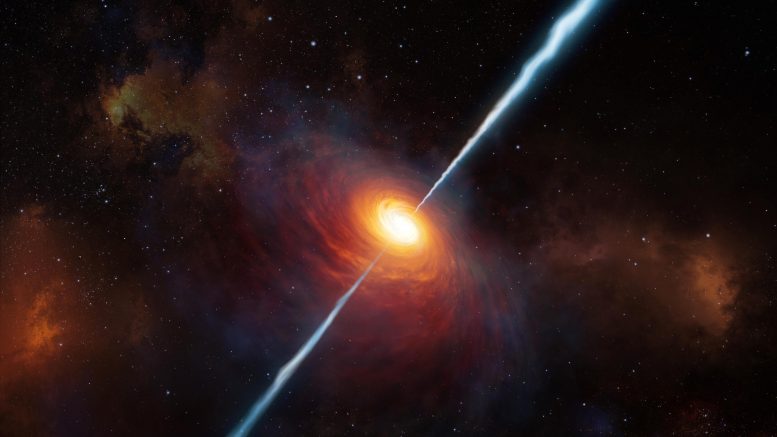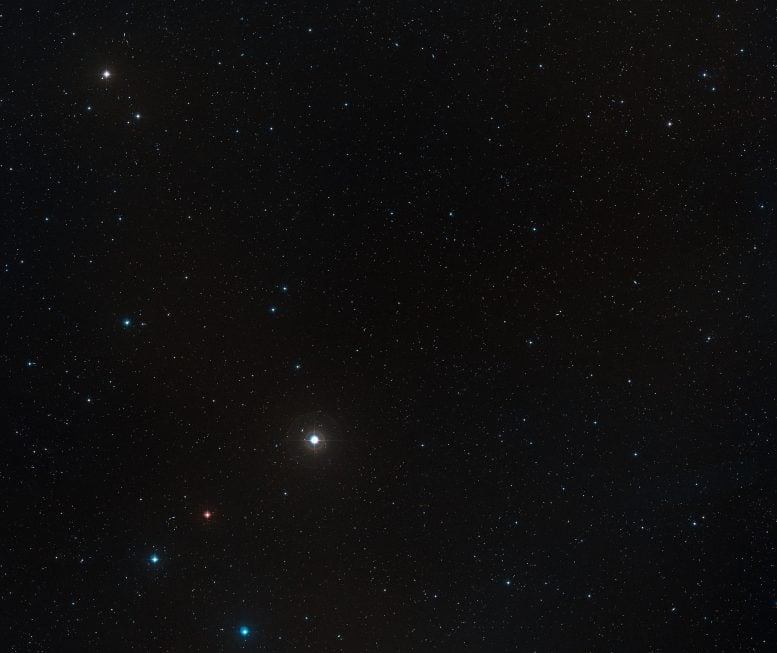
This artist’s impression shows how the distant quasar P172+18 and its radio jets may have looked. To date (early 2021), this is the most distant quasar with radio jets ever found and it was studied with the help of ESO’s Very Large Telescope. It is so distant that light from it has traveled for about 13 billion years to reach us: we see it as it was when the Universe was only about 780 million years old. Credit: ESO/M. Kornmesser
With the help of the European Southern Observatory’s Very Large Telescope (ESO’s VLT), astronomers have discovered and studied in detail the most distant source of radio emission known to date. The source is a “radio-loud” quasar — a bright object with powerful jets emitting at radio wavelengths — that is so far away its light has taken 13 billion years to reach us. The discovery could provide important clues to help astronomers understand the early Universe.
Quasars are very bright objects that lie at the center of some galaxies and are powered by supermassive black holes. As the black hole consumes the surrounding gas, energy is released, allowing astronomers to spot them even when they are very far away.
The newly discovered quasar, nicknamed P172+18, is so distant that light from it has traveled for about 13 billion years to reach us: we see it as it was when the Universe was just around 780 million years old. While more distant quasars have been discovered, this is the first time astronomers have been able to identify the telltale signatures of radio jets in a quasar this early on in the history of the Universe. Only about 10% of quasars — which astronomers classify as “radio-loud” — have jets, which shine brightly at radio frequencies.[1]
P172+18 is powered by a black hole about 300 million times more massive than our Sun that is consuming gas at a stunning rate. “The black hole is eating up matter very rapidly, growing in mass at one of the highest rates ever observed,” explains astronomer Chiara Mazzucchelli, Fellow at ESO in Chile, who led the discovery together with Eduardo Bañados of the Max Planck Institute for Astronomy in Germany.
With the help of ESO’s Very Large Telescope, astronomers have discovered and studied in detail the most distant source of radio emission known to date. The source is a “radio-loud” quasar — a bright object with powerful jets emitting at radio wavelengths — that is so far away its light has taken 13 billion years to reach us. This video summarizes the discovery. Credit: ESO
The astronomers think that there’s a link between the rapid growth of supermassive black holes and the powerful radio jets spotted in quasars like P172+18. The jets are thought to be capable of disturbing the gas around the black hole, increasing the rate at which gas falls in. Therefore, studying radio-loud quasars can provide important insights into how black holes in the early Universe grew to their supermassive sizes so quickly after the Big Bang.
“I find it very exciting to discover ‘new’ black holes for the first time, and to provide one more building block to understand the primordial Universe, where we come from, and ultimately ourselves,” says Mazzucchelli.

This visible-light, wide-field image of the region around the distant quasar P172+18 was created from images in the Digitized Sky Survey 2. The object itself lies very close to the center and is not visible in this picture, but many other, much closer, galaxies are seen in this wide-field view. Credit: ESO and Digitized Sky Survey 2. Acknowledgment: Davide De Martin
P172+18 was first recognized as a far-away quasar, after having been previously identified as a radio source, at the Magellan Telescope at Las Campanas Observatory in Chile by Bañados and Mazzucchelli. “As soon as we got the data, we inspected it by eye, and we knew immediately that we had discovered the most distant radio-loud quasar known so far,” says Bañados.
However, owing to the short observation time, the team did not have enough data to study the object in detail. A flurry of observations with other telescopes followed, including with the X-shooter instrument on ESO’s VLT, which allowed them to dig deeper into the characteristics of this quasar, including determining key properties such as the mass of the black hole and how fast it’s eating up matter from its surroundings. Other telescopes that contributed to the study include the National Radio Astronomy Observatory’s Very Large Array and the Keck Telescope in the US.
This video sequence starts from a wide-field view of the region of the sky around P172+18 and closes in on the very distant quasar, a bright object that lies at the center of a remote galaxy and is powered by a supermassive black hole. The galaxy itself is surrounded by a very large bubble of ionized gas; artist’s impressions of both the bubble and the galaxy are seen in the sequence. The final view is an artist’s impression of the quasar and its radio jets. Credit: ESO/M. Kornmesser/L. Calçada/Digitized Sky Survey 2/N. Risinger (skysurvey.org)
While the team is excited about their discovery, to appear in The Astrophysical Journal, they believe this radio-loud quasar could be the first of many to be found, perhaps at even larger cosmological distances. “This discovery makes me optimistic and I believe — and hope — that the distance record will be broken soon,” says Bañados.
Observations with facilities such as ALMA, in which ESO is a partner, and with ESO’s upcoming Extremely Large Telescope (ELT) could help uncover and study more of these early-Universe objects in detail.
Notes
[1] Radio waves that are used in astronomy have frequencies between about 300 MHz and 300 GHz.
More information
This research is presented in the paper “The discovery of a highly accreting, radio-loud quasar at z=6.82” to appear in The Astrophysical Journal.
The team is composed of Eduardo Bañados (Max-Planck-Institut für Astronomie [MPIA], Germany, and The Observatories of the Carnegie Institution for Science, USA), Chiara Mazzucchelli (European Southern Observatory, Chile), Emmanuel Momjian (National Radio Astronomy Observatory [NRAO], USA), Anna-Christina Eilers (MIT Kavli Institute for Astrophysics and Space Research, USA), Feige Wang (Steward Observatory, University of Arizona, USA), Jan-Torge Schindler (MPIA), Thomas Connor (Jet Propulsion Laboratory [JPL], California Institute of Technology, USA), Irham Taufik Andika (MPIA and International Max Planck Research School for Astronomy & Cosmic Physics at the University of Heidelberg, Germany), Aaron J. Barth (Department of Physics and Astronomy, University of California, Irvine, USA), Chris Carilli (NRAO and Astrophysics Group, Cavendish Laboratory, University of Cambridge, UK), Frederick Davies (MPIA), Roberto Decarli (INAF Bologna — Osservatorio di Astrofisica e Scienza dello Spazio, Italy), Xiaohui Fan (Steward Observatory, University of Arizona, USA), Emanuele Paolo Farina (Max-Planck-Institut für Astrophysik, Germany), Joseph F. Hennawi (Department of Physics, Broida Hall, University of California, Santa Barbara, USA), Antonio Pensabene (Dipartimento di Fisica e Astronomia, Alma Mater Studiorum, Universita di Bologna, Italy and INAF Bologna), Daniel Stern (JPL), Bram P. Venemans (MPIA), Lukas Wenzl (Department of Astronomy, Cornell University, USA and MPIA) and Jinyi Yang (Steward Observatory, University of Arizona, USA).









Um, that is one hell of a radio signal strength. Point blank that would have cut the earth in half. just sayin’…..
? References needed.
– What is the radio signal strength?
– What is your “point blank” distance?
– How would a radio signal “cut” Earth?
If you just want to say your are impressed, say so …
how does ones mind cope with 13 billion light years..more than eternity..just words ..wow the physics of our universe .thank you to the great brains of our kind to discover these wonders..we sponges keep being gob smacked by this ..technology .these insights..from nutrinos too 13 billion light years..what next ..i am 75 love the thought of space—..the laws of physics eternity
A similar quasar with jets reported here: https://www.sciencedaily.com/releases/2021/03/210309153500.htm .
“PJ352-15 breaks a couple of different astronomical records. First, the longest jet previously observed from the first billion years after the big bang was only about 5,000 light-years in length, corresponding to the radio observations of PJ352-15. Second, PJ352-15 is about 300 million light-years farther away than the most distant X-ray jet recorded before it..
“The length of this jet is significant because it means that the supermassive black hole powering it has been growing for a considerable period of time,” said co-author Eduardo Bañados of the Max Planck Institute for Astronomy (MPIA) in Heidelberg, Germany. “This result underscores how X-ray studies of distant quasars provide a critical way to study the growth of the most distant supermassive black holes.””
Quasars are the aurora borealis of black holes.